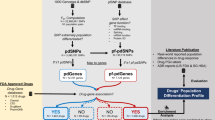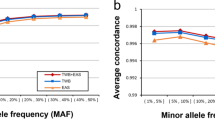Abstract
Single-nucleotide polymorphisms (SNPs), common variations among the DNA of individuals, are being uncovered and assembled into large SNP databases that promise to enable the dissection of the genetic basis of disease and drug response (i.e., pharmacogenomics). Although great strides have been made in understanding the diversity of the human genome, such as the frequency, distribution, and type of genetic variation that exists, the feasibility of applying this information to uncover useful pharmacogenomic markers is uncertain. The health care industry is clamoring for access to SNP databases for use in research in the hope of revolutionizing the drug development process. As the reality of using SNPs to uncover drug response markers is rarely addressed, this review discusses practical issues, such as patient sample size, SNP density and genome coverage, and data interpretation, that will be important for determining the applicability of pharmacogenomic information to medical practice.
This is a preview of subscription content, access via your institution
Access options
Subscribe to this journal
Receive 12 print issues and online access
$209.00 per year
only $17.42 per issue
Buy this article
- Purchase on Springer Link
- Instant access to full article PDF
Prices may be subject to local taxes which are calculated during checkout


Similar content being viewed by others
References
Brower, V. Genome II: the next frontier. Nat. Biotechnol. 16, 1004 (1998).
Marshall, E. Drug firms to create public database of genetic mutations. Science 284, 406–407 (1999).
Venter, J.C. et al. Shotgun sequencing of the human genome. Science. 280, 1540–1542 (1998).
Marshall, E. ‘Playing chicken’ over gene markers. Science 278, 2046–2048 (1997).
Hodgson, J. Curagen lays down markers; 120,000 of them. Nat. BIotechnol. 17, 951 (1999).
Davidson, S. Incyte SNPs up Hexagen for new firm. Nat. Biotechnol. 16, 895 (1998).
Bertina, R.M. et al. Mutation in blood coagulation factor V associated with resistance to activated protein C. Nature 369, 64–67 (1994).
Liu, R. et al. Homozygous defect in HIV-1 coreceptor accounts for resistance of some multiply-exposed individuals to HIV-1 infection. Cell 86, 367–377 (1996).
Krynetski, E.Y. & Evans W.E. Pharmacogenetics as a molecular basis for individualized drug therapy: the thiopurine S-methyltransferase paradigm. Pharm. Res. 16, 342–349 (1999).
Drazen, J.M. et al. Pharmacogenetic association between ALOX5 promoter genotype and the response to anti-asthma treatment. Nat. Genet. 22, 168–170 (1999).
Poirier, J. et al. Apolipoprotein E4 allele as a predictor of cholinergic deficits and treatment outcome in Alzheimer disease. Proc. Natl. Acad. Sci. USA 92, 12260–12264 (1995).
Collins, F.S. Positional cloning: let's not call it reverse anymore. Nat. Genet. 1, 3–6 (1992).
Friedman, T.B. et al. A gene for congenital, recessive deafness DFNB3 maps to the pericentromeric region of chromosome 17. Nat. Genet. 9, 86–91 (1995).
Houwen, R.H.J. et al. Genome screening by searching for shared segments: mapping a gene for benign recurrent intrahepatic cholestasis. Nat. Genet. 8, 380–386 (1994).
Puffenberger, E.G. et al. Identity-by-decent and association mapping of a recessive gene for Hirschsprung disease on human chromosome 13q22. Hum. Mol. Genet. 3, 1217–1225 (1994).
Lai, E., Riley, J., Purvis, I. & Roses, A. A 4-Mb high-density single nucleotide polymorphism-based map around human APOE. Genomics 54, 31–38 (1998).
Risch, N. & Merikangas, K. The future of genetic studies of complex human diseases. Science 273, 1516–1517 (1996).
Zubenko, G.S., Hughes, H.B., Stiffler, J.S., Hurtt, M.R. & Kaplan, B.B. A genome survey for novel Alzheimer disease risk loci: results at 10-cM resolution. Genomics. 50, 121–128 (1998).
Clark, A.G. et al. Haplotype structure and population genetic inferences from nucleotide-sequence variation in human lipoprotein lipase. Am. J. Hum. Genet. 63, 595–612 (1998).
Terwilliger, J.D., Zollner, S., Laan, M. & Paabo, S. Mapping genes through the use of linkage disequilbrium generated by genetic drift: ‘drift mapping’ in small populations with no demographic expansion. Hum. Hered. 48, 138–154 (1998).
Cargill, M. et al. Characterization of single-nucleotide polymorphisms in coding regions of human genes. Nat. Genet. 22, 231–238 (1999).
Halushka, M.K. et al. Patterns of single-nucleotide polymorphisms in candidate genes for blood-pressure homeostasis. Nat. Genet. 22, 239–247 (1999).
Koster, T. et al. Venous thrombosis due to poor anticoagulation response to activated protein C: Leiden Thrombophilia Study. Lancet 342, 1503–1506 (1993).
Idle, J.R. & Smith, R.l. Polymorphisms of oxidation at carbon centers of drugs and their clinical significance. Drug Metab. Rev. 9, 301–317 (1979).
Hartl, D.l. & Clark, A.G. Principles of population genetics. (Sinauer Associates. Sunderland, MA; 1990).
Huttley, G.A., Smith, M.W., Carrington, M. & O'Brien, S.J. A scan for linkage disequilibrium across the human genome. Genetics 152, 1711–1722 (1999).
Jorde, L.B. et al. Linkage disequilibrium predicts physical distance in the adenomatous polyposis coli region. Am. J. Hum. Genet. 54, 884–898 (1994).
Kruglyak, L. Prospects for whole-genome linkage disequilibrium mapping of common disease genes. Nat. Genet. 22, 139–144 (1999).
Lewontin, R.C. The interaction of selection and linkage. I. General considerations; heterotic models. Genetics 49, 49–67 (1964).
Cox, N.J. & Bell, G.I. Disease associations: chance, artifact or susceptibility genes? Diabetes 38, 947–950 (1989).
Osier, M. et al. Linkage disequilibrium at the ADH2 and ADH3 loci and risk of alcoholism. Am. J. Hum. Genet. 64, 1147–1157 (1999).
Saiki, R.K., Walsh, P.S., Levenson, C.H. & Erlich, H.A. Genetic analysis of amplified DNA with immobilized sequence-specific oligonucleotide probes. Proc. Natl. Acad. Sci. USA 86, 6230–6234 (1989).
Chee, M. et al. Accessing genetic information with high-density DNA arrays. Science 274, 610–614 (1996).
Orita, M., Iwahana, H., Kanazawa, H., Hayasi, K. & Sekiya, T. Detection of polymorphisms of human DNA by gel electrophoresis as single-strand conformation polymorphisms. Proc. Natl. Acad. Sci. USA 86, 2766–2770 (1989).
Syvanen, A.C. From gels to chips: “minisequencing” primer extension for analysis of point mutations and single nucleotide polymorphisms. Hum. Mutat. 13, 1–10 (1999).
Barcellos, L.F. et al. Association mapping of disease loci by use of a pooled DNA genomic screen. Am. J. Hum. Genet. 61, 734–747 (1997).
Breen, G. et al. Accuracy and sensitivity of DNA pooling with microsatellite repeats using capillary electrophoresis. Mol. Cell. Probes 13, 359–365 (1999).
Roberts, S.B., MacLean, C.J., Neale, M.C., Eaves, L.J. & Kendler, K.S. Replication of linkage studies of complex traits: an examination of variation in location estimates. Am. J. Hum. Genet. 65, 876–884 (1999).
Fisher, L. Biostatistics: a methodology for the health sciences. (Wiley Science, New York, NY; 1993).
Acknowledgements
We wish to especially thank Joanne Meyer and Steve Lewitzky for critical review of the manuscript and comments.
Author information
Authors and Affiliations
Corresponding author
Rights and permissions
About this article
Cite this article
McCarthy, J., Hilfiker, R. The use of single-nucleotide polymorphism maps in pharmacogenomics. Nat Biotechnol 18, 505–508 (2000). https://doi.org/10.1038/75360
Received:
Accepted:
Issue Date:
DOI: https://doi.org/10.1038/75360
This article is cited by
-
Assessment of clinically actionable pharmacogenetic markers to stratify anti-seizure medications
The Pharmacogenomics Journal (2023)
-
False gene and chromosome losses in genome assemblies caused by GC content variation and repeats
Genome Biology (2022)
-
A single nucleotide polymorphism-based formula to predict the risk of propofol TCI concentration being over 4 µg mL−1 at the time of loss of consciousness
The Pharmacogenomics Journal (2022)
-
Association of Nephronophthisis 4 genetic variation with cardiorenal syndrome and cardiovascular events in Japanese general population: the Yamagata (Takahata) study
Heart and Vessels (2022)
-
Discrimination of single-point mutations in unamplified genomic DNA via Cas9 immobilized on a graphene field-effect transistor
Nature Biomedical Engineering (2021)



